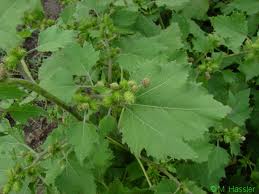| PlantID | 0139 |
| Botanical Name | Xanthium strumarium |
| Common Name | Raktapushpi |
| Classification | | Kingdom: | Plantae | | Subkingdom: | Tracheobionta | | Division: | Magnoliophyta | | Class: | Magnoliopsida | | Subclass: | Asteridae | | Order: | Asterales | | Family: | Asteraceae | | Genus: | Xanthium | | Species: | strumarium |
|
| Part used | Whole plant, fruit, root and seeds. |
| Medicinal Properties | Whole plant: digestive, antipyretic, cooling, laxative, alexiteric, tonic, alterative and anthelmintic. Root:tonic. Fruits: cooling, demulcent. |
| Medicinal Use | This plant's component xanthinin shows antibacterial activity. It resembles sunflower oil and used in bladder infection, herpes, and erysipelas. Whole plant: improves appetite, voice, complexion, and memory. It cures leucoderma, biliousness, poisonous bites of insects, epilepsy, salivation, teeth diseases and fever. Roots: used in cancer, strumous diseases. Fruits: useful in headache. Seeds: fumes inhaled for piles(burnt). |
| Chemistry | Whole plant: xanthinin. Seed: edible oil. |
| Cultivation | Requires a sunny position, prefers a poor dry soil. |
| Regional Habitat | It commonly grows in waste places, along with roadsides and river banks. Distribution: throughout Rajasthan. |
| Description | It's an annual herb with a short, stout, hairy stem. Leaves: broadly triangular-ovate or suborbicular. |
| Image |  |


